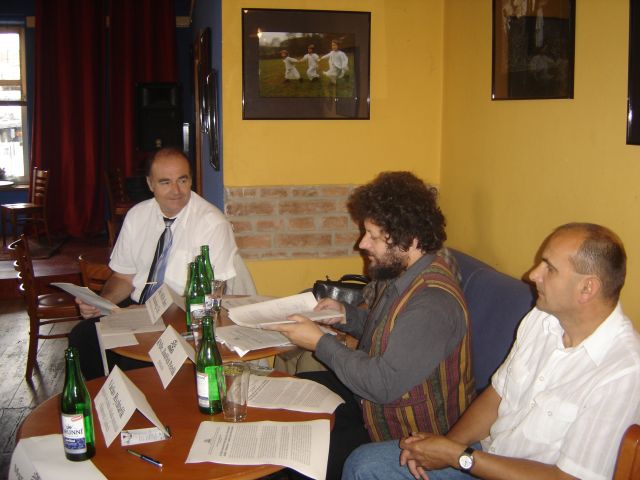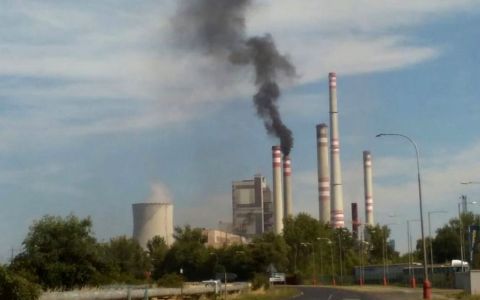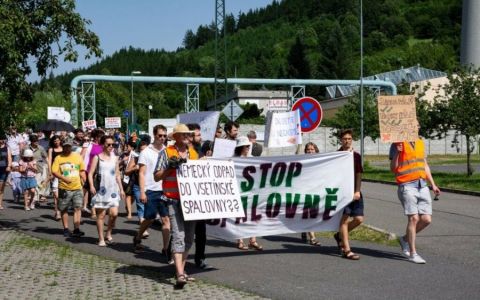Former pesticides storage contaminated with pesticides such as DDT, lindane, or atrazine, which was returned by state in restitution process to its previous owner already contaminated.
White elephant, this is how the restitution of farm buildings in Klatovy – Luby to the family of original owners could be called. The assets were expropriated in the fifties of the twentieth century by the totalitarian state, then after the democratic revolution they got the properties back, but in an unusable state, because it had been used to store pesticides. Today these substances are prohibited worldwide and among the most dangerous substances the man has ever made. The buildings are literally soaked up with chemicals. The whole time, the Rychtařík family – the farm inheritors – have been living there.
Klatovy, referred to as a “Gateway to Šumava”, vast Czech border mountains, are located forty kilometers by West Bohemian metropolis Pilsen. Rychtařík family bought a farm in this part of Klatovy in the year 1925. They lost the property the day of 17 April 1953, when the buildings were confiscated by the communist ruled state as a part of the transformation of individual private agricultural sector into collectivized one. The agricultural cooperative was founded, operating until 1957.
Between the years 1957 to 1974 the farm had been used as an agricultural machinery warehouse, thereafter the Agrochemical company of Klatovy established a warehouse and preparation plant of pesticides (herbicides, fungicides and rodenticides), which was operating until the year 1994. In the winter of that year, the farm buildings were returned to the possession of inheritors of the original owners.
Contaminated farm
 Photo: Jindřich Petrlík/Arnika
Photo: Jindřich Petrlík/Arnika
The farm complex in Luby consists of a warehouse of area 610 m² and paved courtyard of about the same area. There are several wells on adjacent lands, belonging to separate houses. The Rychtařík family have lived for whole generations in the family house on the opposite side of the courtyard, having no idea about the contamination of the farmhouse. Later it turned out that even the well that family used to draw drinking water up to the year 1992 was contaminated.
The real state of things became apparent in the spring 1994. That time Rychtaříks tried to rent the warehouse they didn’t have a use for. The company interested in the renting had processed chemical analysis of plasters and found out that the compound is heavily contaminated by pesticides DDT and lindane.
Even though the use of DDT is prohibited in the Czech Republic since 1974, it was used until 1983 and its residual stocks are found till today in forgotten warehouses throughout the whole country. It is one of the oldest and best known agents of pest control, chlorine based. In 1962 it was found, that DDT penetrates the food chain and accumulates in living organisms. Due to its resistance to natural decomposition it “travels” to localities very distant from the area of use. DDT can cause cancer and has a negative impact on the reproductive system. Correlation was found between this pesticide and reduced ability of birds of prey to bring up their young. In the USA the DDT was blamed for the near extinction of bald eagle.
State turned its back on them
 Photo: Jindřich Petrlík/Arnika
Photo: Jindřich Petrlík/Arnika
Concerned Rychtaříks ordered a detailed survey in 1995. In addition to DDT with its metabolites and lindane, scientists found out that the warehouse is contaminated with other dangerous pesticides HCH, atrazine and fenson. Not only the plasters and floors have absorbed the chemicals, but also the land in the neighbourhood. Contamination level reached the limits of C category, which according to the Ministry of Environment’s guidelines means serious health hazard and a necessity of decontamination of the area. But that would cost hundreds of thousands of euros.
The Rychtařík family got into a precarious situation. Nor the Agrochemical Company Klatovy, nor the state which owned the company before wanted to take responsibility. That was the reason why the family took it to the court. They won the court of first instance, but subsequent appeals were not in their favour. A number of other failed attempts followed when Rychtaříks successively turned to the District Authority of Klatovy, Ministry of Environment, and Office of The Public Defender of Rights. In the end the case was postponed by The Ombudsman because of non-existent support in the then valid laws. Even letters to the Prime minister and President did not help.
In 2003 desperate Mr. Rychtařík turned to the Arnika Association asking for help. Arnika carried out its own sampling. It has been shown that the pesticide residues are for e.g. in the eggs of hens kept by the family and therefore the contamination does not disappear in any way.
Meantime the Agrochemical Company was purchased by Proagro company, which kept the same attitude as its predecessor. Arnika together with the family turned to the Klatovy representatives. Although they said that the solution exceeds the ability of the city to afford it, but promised to help with finding other funding sources. The negotiations with the Minister of Environment had a similar conclusion. In the end the problem of the contaminated warehouse got through to the agenda of Czech Members of European Parliament who were asked by Arnika to help with enforcing of the decontamination.
Contaminated stream
In 2004 International Stockholm Convention came into force in Czech Republic which established stricter control of toxic pollution, including the DDT. Because it had been proven that these substances can persist in the environment in the long term, can be transported over long distances and accumulate in the bodies of animals and humans. Despite the issue of hazardous pesticides was addressed at global forums, the problem of contaminated warehouse in Klatovy was deadlocked.
Inger Schörling, the ex-Member of European Parliament and author of a book about chemicals visited the warehouse in Klatovy on its way to Czech Republic in the winter of 2006. She was so shocked by the extent of contamination in the middle of residential area that she described the contaminated warehouse as a time bomb.
In 2006 Arnika ordered processing of a report on the analysis of fish samples from Drnový stream, located close to the Rychtaříks family house. High concentrations of long time unused pesticides were found and later analysis proved that the source of pollution is the former pesticide warehouse.
Because there was no progress in the negotiations with authorities, Arnika produced an expert report about the contaminated warehouse in Luby, summarizing all the analysis processed during the 2003 to 2007 period and launched a petition “Klatovy without DDT”. In the short time the requirements got support of more than eight hundred people and the problem of Rychtařík family got into focus of local and national media. For Rychtaříks it was a glimmer of hope of improvement.
In the summer of 2007 Arnika handed the petition together with the expert report complexly assessing the extent of contamination of the buildings and adjacent area to the Councillor for the Environment of Pilsen Region who promised financing of the analysis which should serve as supporting document for the request for money for the decontamination of ecological burden. It was clear, that the cost exceeds not only the Rychtaříks ability to afford it but the ability of the region too. What was completely unclear was where to get the necessary money since the claims of individual applicants were not accepted by the Minister of Environment who managed the European funds. Fortunately the case was taken up again by the Office of The Public Defender of Rights, namely its Deputy RNDr. Jitka Seitlová, who pushed the Minister to allow the claims by individuals for the money from European funds.
One year later a risk analysis was ordered, which included the most detailed chemical exploration of the warehouse and its surroundings to date. High concentrations of pesticides and petroleum substances were found in the samples, groundwater pesticide concentrations exceeded the maximum permissible level in several cases. Contamination by pesticides was confirmed in multiple rooms of the warehouse. In a number of cases the concentrations found were even higher than those found by Arnika’s analyses sooner.
The case got into the focus of media once again. Long TV reports were broadcasted by national Czech Television as well as the most watched commercial television TV Nova.
The European funds money
Thanks to the risk analysis, the project with an application for a grant from the Operational Programme –Environment for the period 2007 - 2013 had been processed. It is one of grant programs which allow Czech Republic to draw money of European Union for the protection and improvement of the quality of the environment. Operational Programme – Environment is the second largest operational programme which divided almost 5 billion euros in the given period.
Mr. Rychtařík got help with the preparation of application from specialists from the National Institute of Public Health in Ostrava, who had written the assessment of health risks of living in pesticide contaminated area. In the spring of 2010 The Ministry of the Environment assigned a grant from the operational programme in the amount of 85 percent from the 372 thousands euro generally needed for decontamination of the warehouse. The state had to give five percent and the owner of the object gave the remaining ten percent.
The actual decontamination was launched in autumn 2010 and was divided into two phases and lasted two years. In the first stage contaminated plasters and floors were removed. A total of 100 tons of material was transported to facilities intended for disposal of waste containing persistent organic pollutants. Before the winter the floors and plasters were already replaced and the decontaminated building handed over to Mr. Rychtařík’s. In the second stage, it was necessary to extract 350 tons of soil from around the warehouse contaminated by petroleum products. The soil was subsequently decontaminated on site by so called biodegradation. This method uses the metabolic processes of certain bacteria for the oil substances degradation.
After almost ten years Rychtaříks were returned their buildings and land in pristine condition and do not have to be afraid of a threat to their health from hazardous chemicals anymore. It is not clear what will happen with the cleaned warehouse now. The only condition to receive the state grant was that the building must not be used for commercial purposes in the next five years. It seems that there will be no offices here, not even after decontamination, but it should be possible to use it as a warehouse at least.
Thanks to the support of a national organisation the independent analysis of the extent of contamination of buildings and the surrounding environment could have been performed. The results of the analyses along with a petition provoked media interest and pressure on the politicians who did not want to deal with the case for a long time. Decontamination of the warehouse was made possible thanks to the financial resources of the European funds because it was so difficult to find such a large sum elsewhere.
 Photo: Arnika/archive
Photo: Arnika/archive
“I met with Arnika in 2003 when I turned to it for help in case of pesticide warehouse in Klatovy – Luby. Arnika carried out a list of analyses on the location and the media pressure to remove the burden based on these findings. Further Arnika developed a comprehensive study and organised a petition for the removal of the old environmental burden. But above all they convinced Pilsen Region, to develop a risk analysis. And this is why the whole of Arnika deserves huge thanks.”
Václav Rychtařík, the owner of contaminated buildings in Klatovy - Luby







